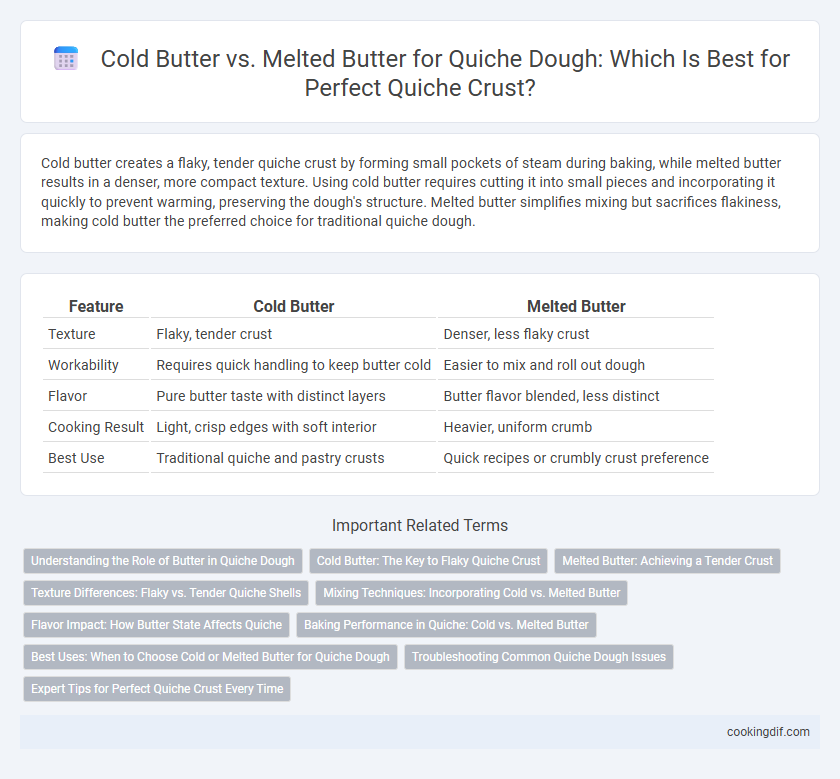Cold butter creates a flaky, tender quiche crust by forming small pockets of steam during baking, while melted butter results in a denser, more compact texture. Using cold butter requires cutting it into small pieces and incorporating it quickly to prevent warming, preserving the dough's structure. Melted butter simplifies mixing but sacrifices flakiness, making cold butter the preferred choice for traditional quiche dough.
Table of Comparison
| Feature | Cold Butter | Melted Butter |
|---|---|---|
| Texture | Flaky, tender crust | Denser, less flaky crust |
| Workability | Requires quick handling to keep butter cold | Easier to mix and roll out dough |
| Flavor | Pure butter taste with distinct layers | Butter flavor blended, less distinct |
| Cooking Result | Light, crisp edges with soft interior | Heavier, uniform crumb |
| Best Use | Traditional quiche and pastry crusts | Quick recipes or crumbly crust preference |
Understanding the Role of Butter in Quiche Dough
Cold butter creates a flaky and tender texture in quiche dough by forming distinct layers during baking, while melted butter results in a denser, more uniform crust. The temperature of butter affects gluten development and dough elasticity, critical for achieving the perfect crust structure. Properly chilled butter slows gluten formation, contributing to a flakier, more desirable quiche base.
Cold Butter: The Key to Flaky Quiche Crust
Cold butter is essential for achieving a flaky quiche crust because it creates small, solid pockets in the dough that release steam during baking, resulting in a tender, layered texture. Using cold butter prevents it from fully blending into the flour, which helps maintain the dough's structure and prevents it from becoming tough. This technique is favored in classic French quiche recipes to ensure the perfect balance of crispness and delicate flakiness.
Melted Butter: Achieving a Tender Crust
Melted butter in quiche dough enhances tenderness by evenly distributing fat, resulting in a softer, more pliable crust. This method reduces the risk of overworking the dough, preventing toughness commonly caused by solid butter. The melted butter's moisture integrates smoothly, producing a delicate texture that complements the quiche's creamy filling.
Texture Differences: Flaky vs. Tender Quiche Shells
Cold butter in quiche dough creates a flaky texture by forming small pockets of steam during baking, resulting in a crisp, layered crust. Melted butter produces a tender, more uniform dough with less lift, yielding a softer and denser quiche shell. Choosing cold butter enhances flakiness, while melted butter favors a delicate, melt-in-your-mouth bite.
Mixing Techniques: Incorporating Cold vs. Melted Butter
Cold butter creates a flaky quiche dough by staying solid during mixing, resulting in small, distinct pockets of fat that release steam during baking. Melted butter, when incorporated, produces a denser, more uniform dough lacking the characteristic flakiness. Proper mixing technique with cold butter involves cutting it into flour until pea-sized bits form, whereas melted butter blends smoothly, affecting texture and structure.
Flavor Impact: How Butter State Affects Quiche
Cold butter creates a flakier, more tender quiche crust by forming distinct layers during baking, enhancing texture and mouthfeel. Melted butter results in a denser dough with a richer, buttery flavor that infuses more uniformly throughout the crust. Choosing between cold and melted butter directly affects the balance of crispness and flavor intensity in the final quiche.
Baking Performance in Quiche: Cold vs. Melted Butter
Cold butter in quiche dough produces a flakier, more tender crust by creating distinct layers as it melts during baking, enhancing texture and overall structure. Melted butter results in a denser, less flaky crust due to the lack of steam pockets that develop from solid butter pieces. For optimal baking performance in quiche, cold butter is preferred to achieve a crisp yet delicate pastry base.
Best Uses: When to Choose Cold or Melted Butter for Quiche Dough
Cold butter in quiche dough creates a flakier, more tender crust by forming solid fat pockets that steam during baking, ideal for traditional quiche recipes that require a delicate texture. Melted butter results in a denser, more uniform dough, best suited for quiches where a sturdy, less crumbly crust is desired, such as those with heavier fillings. Choosing cold or melted butter depends on the quiche's desired texture and filling weight, with cold butter preferred for light, airy crusts and melted butter for robust, firm bases.
Troubleshooting Common Quiche Dough Issues
Cold butter in quiche dough creates a flaky, tender crust by forming small pockets of steam during baking, preventing toughness and excessive shrinkage. Melted butter, while easier to incorporate, often results in a denser, less crisp texture and can cause the dough to become greasy or overly soft. For troubleshooting common issues like crumbly or hard crusts, maintaining cold butter and minimal handling is crucial to achieving the ideal quiche dough consistency.
Expert Tips for Perfect Quiche Crust Every Time
Cold butter is essential for achieving a flaky quiche crust as it creates steam pockets during baking, resulting in a tender, layered texture. Melting the butter beforehand can lead to a dense, tough quiche dough by causing gluten overdevelopment. Expert bakers recommend cutting cold butter into the flour quickly to maintain proper temperature and texture, ensuring a consistently perfect quiche crust every time.
Cold butter vs melted butter for quiche dough Infographic

 cookingdif.com
cookingdif.com